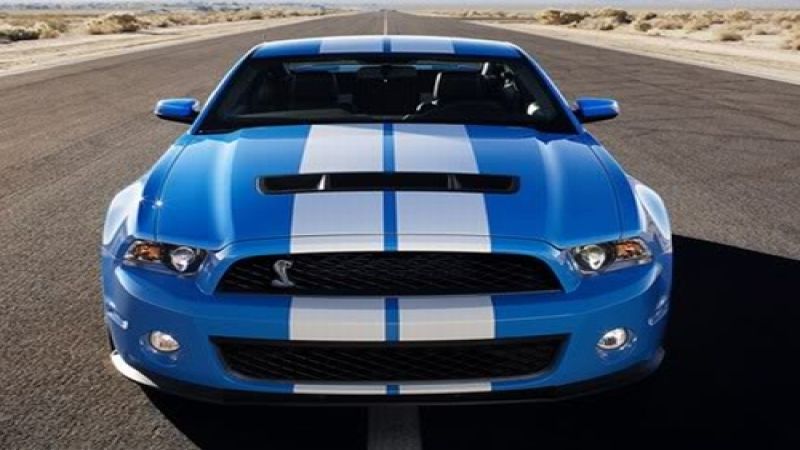When you look at a comparison in just about any magazine, you will see that the Mustang almost always beats the Camaro and the Challenger in terms of speed and handling. The reason is simple: It's hundreds of pounds lighter than both of them. It doesn't matter that the Mustang has the smallest, least powerful engine, or the rear suspension from an ox-cart, it simply out performs it's brethren.
Small and light is all relative because if you were to take each generation Mustang from the past 50 years and put them together, you will be gob-smacked at how big and bloated the Mustang has become. The Mustang name is famous the world over, but its weight and suspension has kept it from being sold overseas. With Ford wanting to become a global company with global products, keeping a fat Mustang stateside-only is no longer an option. It must create a Mustang that the whole world will love.
Ford is apparently taking drastic steps for the 50th anniversary of the famous pony car. Rumors suggest a physically smaller car that is several hundred pounds lighter than the current model. This will not only increase acceleration and handling, but also increase fuel efficiency. We can all agree that this is a good thing.
The second thing to change, however, would be the live-axle rear end that is basically a stick with two wheels at each end, similar to a chariot. The advantages are that it's very strong and cheap, the disadvantage is that it's not as plush and doesn't grip the road in turns or bumps as well as an independent rear suspension. In just about every form of auto racing where both left AND right turns are used, the cars will have independent rear suspensions.
Drag racing is a big part of American culture, especially the culture of the Mustang, and a live-axle is the axle of choice in this sport. Here, understandably, people would be upset. If the car is destined to be sold, the drag racers will have to be left disappointed initially (I say initially because live-axles will quickly be retrofitted into these cars for drag racing use. When that happens, nobody will make a big stink about it anymore.)
If you've ever driven in Europe you'll noticed that there is hardly a straight road in the entire continent. The roads are as twisty as a garden vine and change elevation constantly. These types of roads frown upon heavy, lumbering cars. Small and light are what people here want, which is why although the Mustang name is famous, few people have bought one.
Expect other European tastes to make their way into the Mustang. European cars generally have a much higher quality interior than their American counterparts. Less plastic and much better fit and finish are very important to European tastes. This is something we can definitely learn enjoy as well in North America.
Regarding power-plants, rumors are also floating around about Ford adding another engine to the current 3.7 liter v6 and the 5.0 v8 lineup, namely a turbocharged 4 cylinder. If you think that's blasphemy, you'd be wrong, since in 1984-1986 a high performance version of the Mustang called the SVO was introduced to take on the non-911 Porsches that were coming into this country. A 300hp turbocharged four cylinder in a light weight Mustang with a high quality interior? Yes please, but only after I have a v8 version in the garage.












Comments
WIth a current curb weight of
Permalink
WIth a current curb weight of 3604 pounds, and horsepower rated at 413hp, the 2012 Mustang has a power/weight ratio of 8.73 lbs / horsepower.
(The E90 M3 from BMW is 3,700-4,145 pounds depending on trim BTW)
Removing 300-400 (several hundred) pounds from the car and giving it 27% less horsepower would net a ratio of 10.68 lbs / horsepower.
Excuse me if my enthusiasm is not overwhelming - but I'll pass on a turbo 4 cylinder thanks. I agree a V8 with an independent rear suspension would get my attention. We've had a lot of fun putting the IRS from 2003-2004 Cobras in a few cars.
__________
Lab Manager
Mustang Lab
I have a 1985.5 SVO and
Permalink
In reply to WIth a current curb weight of by Lab Manager (not verified)
I have a 1985.5 SVO and although it is not as fast as a 5.0 was at the time, it still is a fantastic little car with a much more balanced weight distribution. the Koni shocks aside, it easily out-handled its 5.0 brethren. I have a feeling that the future turbo 4 would do the same.
Ford spent millions developing the Coyote and the 3.7, they would surely stay with the Mustang. The rumored turbo 4 would simply be an addition.
The SVO is a great car. It
Permalink
In reply to I have a 1985.5 SVO and by Anonymous (not verified)
The SVO is a great car. It had several unique components that made it a great handling car back in the 80's. Sway bar, K-Member, Brakes, Shocks, Struts, Springs and 200 pounds of weight removed from the front end.
Fast forward two decades - the S197 platform handles great. It doesn't have as many glaring problems as the early Fox platform. Any suspension goodies that can get you around a racetrack are already available (unlike those dark ages of the 80's) Simply put, if Ford sticks a tiny 300hp engine in the new mustang, it isn't going to be a significant performance enhancer.
One of my toys is a 2,800 lb coupe. It gets a lot of respect from "Worldly" cars on the road courses. It wouldn't be faster if I gave up 120hp to shed 200 pounds of vehicle weight. I can't imagine the math is much different for a new car. And yes - this car still has the barbaric solid axle.
If you want a turbo 4 cylinder - get an Evo, not a Mustang.
Having a V4 that produces 300
Permalink
In reply to WIth a current curb weight of by Lab Manager (not verified)
Having a V4 that produces 300 HP is equivalent to the current V6 producing 305 HP.
Current Design Calculations:
2012 Base V6 -> 3602 lbs @ 305 HP = 11.8
2012 GT V8 -> 3602 lbs @ 413 HP = 8.7
2012 Boss V8 -> 3602 lbs @ 444 HP = 8.1
2012 GT500 V8 -> 3602 lbs @ 550 HP = 6.5
Rumored 2014 Redesign:
2014 Base V4 -> 3202 lbs @ 300 HP = 10.7
2014 GT V8 -> 3202 lbs @ 500 HP = 6.4
Possible:
2014 V6 -> 3202lbs @ 413 HP = 7.7
2014 Boss -> 3202 @ 550 HP = 5.8
2014 GT500 -> 3202 lbs @ 600+ HP < 5.3
From this calculation, if Ford goes this route would mean that each version would see an improvement not a decrease in the power to weight ratio (weight to power ratio). Thus my interest and excitement is currently high. I just hope that the prices don't skyrocket to own one of these. Sort of digging the new redesign and the potential power that they may have.
If they wanna blow 50
Permalink
If they wanna blow 50 yrs....its their demise, improve on the COYOTE engine program for power, fuel mileage...handling..and they will not be able to make enough of them..PERIOD!
Not sure what you mean here
Permalink
In reply to If they wanna blow 50 by Anonymous (not verified)
Not sure what you mean here since the Mustang is simply losing weight and ADDING engines. Don't see how that's a bad thing at all. I'm confused as how that's blowing 50yrs.
I read this comment as an
Permalink
In reply to Not sure what you mean here by Anonymous (not verified)
I read this comment as an argument against the change from a solid axle to independent rear. Most Mustang fans really like solid axle for the drag race / stoplight challenges. Typically, it gets very expensive to put a lot of horsepower through an independent rear suspension on a Mustang without breaking half-shafts.
Nobody can argue with a car that weighs less. I will argue against an engine that makes less power - how can that be good? If you want less power - buy the V6 and unplug a spark plug wire. You'll probably still get 31mpg :)
__________
Lab Manager
www.mustanglab.com
im saying 5.0ecoboost
Permalink
im saying 5.0ecoboost allwheeldrive . they have already played with the engine now just take the awd from the taurus put them together and WOW. remember the awd cosworth escort the gov said was to fast for america and would'nt let ford sell it here.
Awd? You can't be serious...
Permalink
In reply to im saying 5.0ecoboost by Anonymous (not verified)
Awd? You can't be serious...
livernois motorsports tuned a
Permalink
In reply to Awd? You can't be serious... by Anonymous (not verified)
livernois motorsports tuned a bonestock SHO and outrun a bonestock 2011 mustang gt its on youtube
I''ll pass on the 4 cylinder
Permalink
I''ll pass on the 4 cylinder turbo, but i would welcome open arms an either V8 twin turbo or a V8 Single turbo making about 450-480 BHP since the new GT500 would pack 600HP
As far as IRS goes and those
Permalink
As far as IRS goes and those concerned about losing the live (solid) rear axle, it might not be too difficult to include it as an option. As has been mentioned, it's only advantage is for high-horsepower drag racing so just make it an option. Bring back the Ford Mustang "Drag Pack" option of the late sixties. Problem solved.
Regarding 5.0L V8 Cammer vs 3.5/3.7L V6 EcoBoost, people seem to be confused. It is not an either or. It is which option do you want to tick-off on the order sheet. I'm quite sure there will also be a I-4 EcoBoost option as well to satisfy those that don't need enlarged #'s to compensate for other issues. ;=) Seroiusly though, I'm hoping and trust that Ford will continue to get things right this time round. They've done a great job lately with the Boss 302 etc., and will likley continue with something for everyone. I'll take one of each, in different colors.
The 3.5/3.7L V6 EcoBoost would represent a weight saving of about 100 pounds over the front end most of which would be removed from over or in front of the axle. This has a far greater effect than just reducing the power-to-weight ratio as some have suggested. That is only a loss for acceleration. In all other areas, braking, cornering, transitions, ride, overall handling and fuel economy, it is a big plus. Furthermore, the figures mentioned for the EcoBoost can easily be improved on without any issues. The F-150 EcoBoost in it's very mild tune would be a great starting point - 365 hp @5500 rpm and 420 lb·ft @2500 rpm with 90% torque @1700-5000 rpm. That would outrun a stock cammer in the quarter mile every single day and even more so if the weather were bad (FI vs NA). So all I'm asking is for Ford to give us the choices and someone give me the money to buy one of each. 8=)))